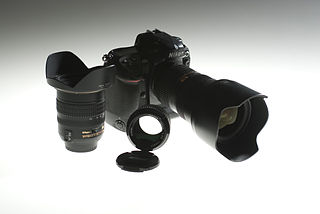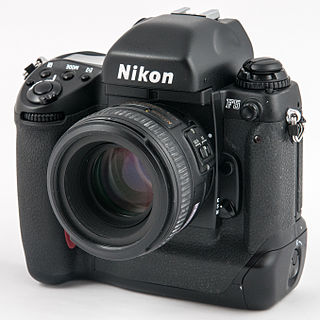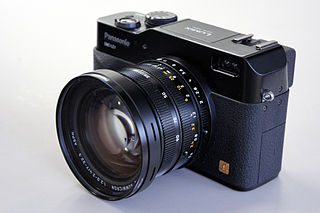
A rangefinder camera is a camera fitted with a rangefinder, typically a split-image rangefinder: a range-finding focusing mechanism allowing the photographer to measure the subject distance and take photographs that are in sharp focus. Most varieties of rangefinder show two images of the same subject, one of which moves when a calibrated wheel is turned; when the two images coincide and fuse into one, the distance can be read off the wheel. Older, non-coupled rangefinder cameras display the focusing distance and require the photographer to transfer the value to the lens focus ring; cameras without built-in rangefinders could have an external rangefinder fitted into the accessory shoe. Earlier cameras of this type had separate viewfinder and rangefinder windows; later the rangefinder was incorporated into the viewfinder. More modern designs have rangefinders coupled to the focusing mechanism so that the lens is focused correctly when the rangefinder images fuse; compare with the focusing screen in non-autofocus SLRs.

Leica Camera AG is a German company that manufactures cameras, optical lenses, photographic lenses, binoculars, and rifle scopes. The company was founded by Ernst Leitz in 1869, in Wetzlar, Germany. The name Leica is derived from the first three letters of the founder's surname (Leitz) and the first two of the word camera: lei-ca.

Minolta Co., Ltd. was a Japanese manufacturer of cameras, camera accessories, photocopiers, fax machines, and laser printers. Minolta Co., Ltd., which is also known simply as Minolta, was founded in Osaka, Japan, in 1928 as Nichi-Doku Shashinki Shōten. It made the first integrated autofocus 35 mm SLR camera system. In 1931, the company adopted its final name, an acronym for "Mechanism, Instruments, Optics, and Lenses by Tashima".

The Nikon D2X is a 12.4-megapixel professional digital single-lens reflex camera (DSLR) that Nikon Corporation announced on September 16, 2004. The D2X was the high-resolution flagship in Nikon's DSLR line until June 2006 when it was supplanted by the D2Xs and, in time, the Nikon D3 range, Nikon D4 range, the Nikon D5 and the Nikon D6— the latter four using a FX full-format sensor.

Seiko Epson Corporation, commonly known as Epson, is a Japanese multinational electronics company and one of the world's largest manufacturers of printers and information- and imaging-related equipment. Headquartered in Suwa, Nagano, Japan, the company has numerous subsidiaries worldwide and manufactures inkjet, dot matrix, thermal and laser printers for consumer, business and industrial use, scanners, laptop and desktop computers, video projectors, watches, point of sale systems, robots and industrial automation equipment, semiconductor devices, crystal oscillators, sensing systems and other associated electronic components.

Cosina Co., Ltd. is a manufacturer of high-end optical glass, optical precision equipment, cameras, video and electronic related equipment, based in Nakano, Nagano Prefecture, Japan.

A digital single-lens reflex camera is a digital camera that combines the optics and the mechanisms of a single-lens reflex camera with a solid-state image sensor and digitally records the images from the sensor.
The Leica Digilux 1 is a digital camera developed in partnership with Panasonic, which was released in 2002, roughly the same time as the Canon PowerShot G2 and the Nikon 2000. It is the second of Leica's digital offerings. Where the original Digilux was developed in partnership with Fuji Camera, the Digilux 1 was developed jointly with Panasonic; Leica is responsible for optics, while Panasonic designs the camera electronics. According to Leica, this allows both companies to design cameras that creates a harmonious matching of lens to sensor to produce color and contrast to Leica standards.

The Nikon F5 is a professional 35 mm film-based single-lens reflex camera body manufactured by Nikon from 1996 through 2004. It was the fifth in Nikon's professional film camera line, which began in 1959 with the Nikon F. It followed the Nikon F4 of 1988, which introduced in-body autofocus to Nikon's professional line. The F5 was in turn succeeded by the Nikon F6, as well as Nikon's parallel range of professional digital SLRs, beginning with the Nikon D1.

Lumix is Panasonic's brand of digital cameras, ranging from pocket point-and-shoot models to digital SLRs.

The Leica M8 is the first digital camera in the rangefinder M series introduced by Leica Camera AG on 14 September 2006. It uses an APS-H 10.3-megapixel CCD image sensor designed and manufactured by Kodak.

The Leica M mount is a camera lens mount introduced in 1954 with the Leica M3, and a range of lenses. It has been used on all the Leica M-series cameras and certain accessories up to the current film Leica M-A and digital Leica M11 cameras.

The Konica Hexar RF is a 35 mm rangefinder camera which was sold by Konica. It was introduced to the market on 13 October 1999. and subsequently discontinued some time before the end of 2003. The camera used the "Bayonet Konica KM-mount", a copy of the Leica M-mount, thus sharing interchangeable lenses with those designed for Leica cameras and others compatible with them. The Hexar RF has a combined rangefinder/viewfinder modeled on that of Leica cameras, a similar body shape and size - and so is similar to Leica M-mount cameras in many aspects of operation.

The Konica Hexar is a 35 mm fixed-lens, fixed focal length autofocus camera which was produced through the 1990s. It was introduced to the market in 1993. While styled like a rangefinder camera, and intended for a similar style of photography, in specification it is more like a larger "point and shoot" camera.

The Bessa family of cameras was manufactured in Japan by Cosina as a revival of the Voigtländer brand name between 1999 and 2015.

The Sigma DP2 is a high-end compact digital camera introduced by the Sigma Corporation. It features a 14-megapixel Foveon X3 sensor, the same sensor used in its predecessor, the Sigma DP1 and in the Sigma SD14 DSLR, a fixed 24.2mm f/2.8 lens, a 2.5” LCD and a pop-up flash.

A mirrorless camera is a digital camera which, in contrast to DSLRs, does not use a mirror in order to ensure that the image presented to the photographer through the viewfinder is identical to that taken by the camera. They have come to replace DSLRs, which have historically dominated interchangeable lens cameras. Other terms include electronic viewfinder interchangeable lens (EVIL) cameras and compact system cameras (CSCs).

The Leica M is a full-frame digital rangefinder camera of Leica Camera AG. It was introduced in September 2012, and is the successor to the Leica M9 range of cameras. The M uses a 24-megapixel image sensor. The camera is the first M model to feature movie recording, and the first to have Live View, which allows the scene, as viewed through the lens, to be composed. The M can use most M- and R-mount lenses. Leica M cameras are made by hand in Portugal and Germany. There is also a version, the M Monochrom, with a monochrome, rather than colour, sensor.

The Leica M10 is a full-frame digital rangefinder camera in Leica Camera AG's rangefinder M series. It accepts Leica M-mount lenses. The camera model was introduced on 19 January 2017. It is a successor to the Leica M9; and has similarities with and differences to the Leica M, Leica M, and Leica M Monochrom. There are five variants of the M10 line—the M10,M10-P,M10-D, and M10 Monochrom and M10-R.


















